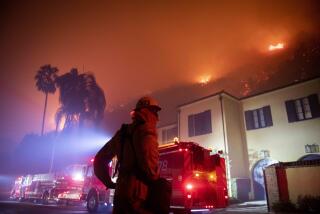20 years after Northridge, are homeowners ready for a quake?

Almost exactly 20 years ago, early on the morning of Jan. 17, 1994, residents of the San Fernando Valley were jolted awake by incredible shaking. Within moments, the Santa Monica Freeway — the major east-west artery in Los Angeles — came crashing down in huge sections; apartment houses pancaked, trapping and killing residents; and houses toppled off their foundations.
It was no wonder. The magnitude 6.7 Northridge earthquake had just produced the strongest ground motions ever recorded in any American urban environment. That 20 seconds of violent shaking killed 57 people and seriously injured thousands more. It caused an estimated $42 billion in damage, resulted in nearly 300,000 residential insurance claims and rendered 14,000 homes and apartments uninhabitable in neighborhoods stretching from the Valley to the coast.
The Northridge quake also rocked California’s homeowner insurance market. Why? In 1985, a California law went into effect that required insurers selling homeowner insurance to also offer earthquake coverage. That meant quake insurance was available to families living in any California house, condo, mobile home or apartment.
PHOTOS: The 1994 Northridge earthquake
But, stung by their unprecedented Northridge losses, many insurers decided quake coverage was too risky. Because state law required them to offer it, many insurers simply quit writing new homeowner policies in California.
Without access to insurance, the ability of 32 million Californians to buy new homes or sell their existing ones was in serious jeopardy. Because insurers’ worries about earthquake risk had led to an almost totally frozen homeowners insurance market, state leaders had to act. Their solution was to establish the California Earthquake Authority, or CEA, which offers the residential earthquake insurance that most private insurers were no longer willing to provide.
But homeowners haven’t fully embraced this access to insurance. Whereas in 1994 almost a third of California households had earthquake insurance, today only 11% of California homes are insured for earthquake damage. This lack of coverage could be disastrous. After the Northridge earthquake, insurance paid for fully half of the residential damage; if that same quake happened today, less than a quarter of the losses would be paid by insurance. Without quake insurance, many more Californians could face financial devastation in the next major earthquake, and whole neighborhoods and communities could find themselves struggling to recover.
We know it’s only a matter of time before the next big quake hits. Scientists have identified additional blind thrust faults like the one that caused the Northridge earthquake, and they have made clear we are long overdue for another major quake on some of the faults in California’s complex system.
So, why do so few of us carry earthquake insurance? One reason is denial, the common and simple belief that “it won’t happen to me.” Some people mistakenly assume that the government will step in to rebuild homes after an earthquake.
And then there are those who wrongly believe their homeowners insurance automatically covers earthquake damage. But that’s simply not true. Without a separate earthquake insurance policy, the uninsured resident is responsible for all the costs of repairing or rebuilding, replacing personal property and living elsewhere if a home is too damaged.
Many Californians tell me they just can’t afford earthquake insurance, or that they can’t find a good, affordable policy. For those who have this concern, I urge you to look again at policies offered by the CEA: In the last 16 years, the agency has increased coverage options and lowered rates. It now offers many new policy choices worth considering.
For those deterred by the high deductibles of 10% to 15% on catastrophic earthquake policies, consider that with CEA coverage, that deductible acts as a kind of trigger: Once the value of covered damage exceeds the deductible, claim payment can begin.
As with any insurance, you absolutely need to have it before a loss occurs. California residents should let the Northridge anniversary serve as a reminder to evaluate whether they are sufficiently protected from the potentially devastating losses an earthquake may bring. Perhaps you should think about retrofitting your home, or buying an earthquake policy, or a combination of both.
Homes are the biggest financial asset many California families possess. All of us know it’s not a matter of if but when the next catastrophic earthquake will strike the state. Living here also means preparing for those damaging earthquakes, and taking simple, sensible steps to protect your home and family from the financial devastation that earthquakes can bring.
Dave Jones is California’s insurance commissioner.
More to Read
A cure for the common opinion
Get thought-provoking perspectives with our weekly newsletter.
You may occasionally receive promotional content from the Los Angeles Times.






